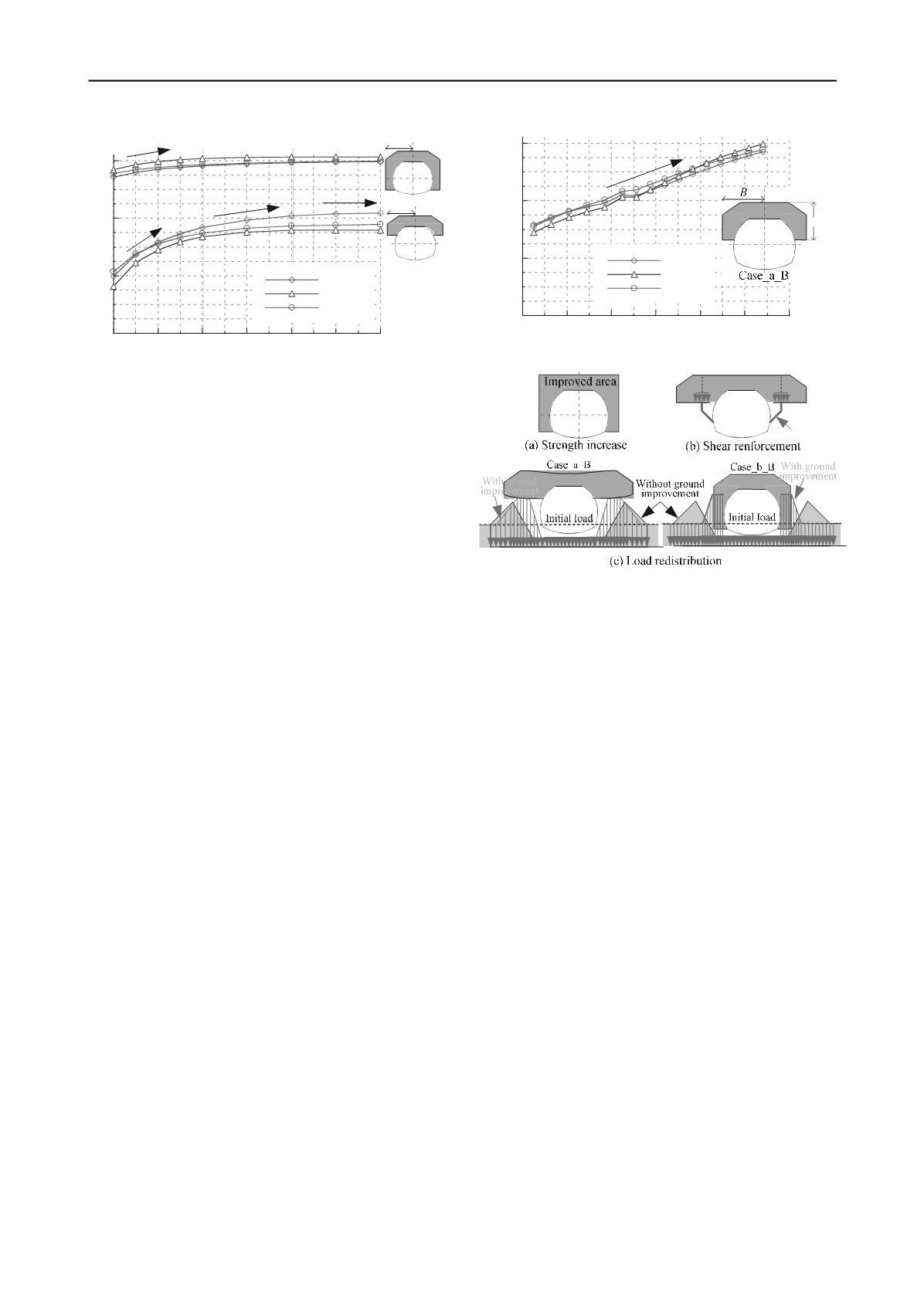
1694
Proceedings of the 18
th
International Conference on Soil Mechanics and Geotechnical Engineering, Paris 2013
40
60
80
100
6
7
8
9
10
11
12
Foot
Crown
Surface
Reduce ratio of settlements [%]
Width of the improved ground [m]
B
Case_b_B
B
Case_a_B
Figure 11. Influence of width of improved ground
becomes larger. For the Case_a_B series, the reduced ratios of
the settlements increase rapidly when the widths are smaller
than 8 m; they reach a peak of 90% when the widths are larger
than 10.5 m. For the Case_b_B series, the reduced ratio of the
settlements of the tunnel and the ground are larger than 95% in
all of the cases.
A series of numerical analyses, that changed the height of
the improved area, was carried out in this research work. Figure
12 shows the reduced ratios of the settlements of the ground
surface and the tunnel for different heights of the improved area.
The analytical results indicate that the settlement-preventing
effect increases when the height of the improved area becomes
larger, linearly.
5 CONCLUSIONS
The mechanical behaviors of the ground and tunnels have been
discussed in this research work in order to clarify the effect of
the pre-ground improvement method. The effect of the pre-
ground improvement method and the influence of the width and
the height of the improved area are shown in the following.
(1) The ground improvement method can prevent the settlement
of the ground and the tunnel, and this effect becomes more
effective as the width and the height of the improved area
increases.
(2) The influenced area due to the tunnel excavation becomes
narrow when improved the ground around all cross section
of the tunnel lining.
(3) The height of the improved ground has a more significant
influence than the width of the improved ground on the
effect of the prevention of settlements.
Moreover, from the above analytical results, the advantage
of the effect of the pre-ground improvement method is
presented as the three matters as shown in Figure 13.
The first one is the effect of strength increase. The strength
of the ground increases due to the ground improvement. As a
result, the deformation of the ground has been prevented by the
pre-ground improvement method. Moreover, the deformation of
the tunnel lining can be prevented by the restriction of the
improved grounds.
The second one is the effect of shear reinforcement. Large
shear strain is generated from the foot of the tunnel and
develops to the ground surface, as shown in Figure 13(b),
during the tunnel excavation process. When the improved areas
are deep enough or wide enough to cover the large shear strain
area, the development of the shear strain will be intercepted by
the improved ground. As a result, the settlement of the ground
can be prevented. For the cases in which all the cross sections of
the tunnel were improved, as in Case_b_B, the effect of shear
reinforcement has been obtained, independent of the width of
the improved ground. On the other hand, the pre-ground
improvement method exerts the effect of shear reinforcement
when the width of the improved ground is wider than a certain
value, in series Case_a_B.
40
60
80
100
5
6
7
8
9
10
11
Foot
Crown
Surface
Reduce ratio of settlements [%]
Height of the improved ground
H
[m]
Figure 12. Influence of height of improved ground
Figure 13. Mechanism of effect of pre-ground improvement method
The third one is the effect of earth pressure redistribution.
The vertical earth pressure is concentrated in the lower part of
the improved area, and the earth pressure acting on the other
area becomes smaller, as shown in Figure 13(c). Moreover, the
influenced area becomes smaller when all the cross sections of
the tunnel are improved as series Case_b_B, although there is
almost no change when only the area around the top section is
improved as series Case_a_B.
In addition, these three kinds of effects become even more
effective as the width and the height of the improved ground
increase.
6 ACKNOWLEDGEMENTS
This work was supported by Grant-in-Aid for Young Scientists
(B) No. 24760384 from MEXT Japan.
7 REFERENCES
Cui, Y., Kishida, K. and Kimura, M. 2010. Analytical study on the
control of ground subsidence arising from the phenomenon of
accompanied settlement using footing reinforcement pile, Deep and
Underground Excavation,
ASCE Geotechnical Special Publication
,
307-312.
Cui, Y., Kishida, K., Kimura, M., Iura, T. and Nonomura, M. 2012.
Effect of ground improvement method on control of ground
subsidence occurring in shallow NATM tunnel excavation,
Proceedings of World Tunnel Congress 2012
, 385-386.
Iizuka, A. and Ohta, H. (1987). A Determination Procedure of Input
Parameters in Elasto-Viscoplastic Finite Element Analysis,
Soils
and Foundations
, 27 (3), 71-87.
Kitagawa, T., Goto, M., Isogai, A., Yashiro, K. and Matsunaga, T. 2005.
Analysis on behaviour of soft ground tunnels with low earth
covering during tunnel excavation,
Proceedings of Tunnel
Engineering, JSCE
, Vol. 15, 203-210. (In Japanese)
Kitagawa, T., Goto, M., Tamura, T., Kimura, M., Kishida, K. Cui, Y.
and Yashiro, K. 2009. Experimental studies on tunnel settlement
reduction effect of side piles,
Doboku Gakkai Ronbunshuu
F, Vol.
65, No. 1, 73-83. (In Japanese)
Nakai, T. and Hinokio, M. 2004. A simple elastoplastic model for
normally and over consolidated soils with unified material
parameters,
Soils and Foundations
, Vol. 44, No. 2, 53-70.


